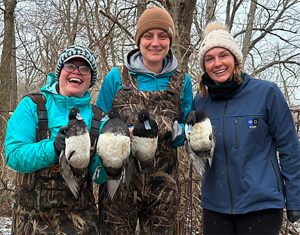NIU doctoral student seeks to solve mystery of waterfowl species’ decline
Northern Illinois University — March 17, 2024
Cheyenne Beach (left), Dr. Auriel Fournier (middle), and Dr. Jennifer Koop prepare to release Lesser scaup back into the wild at the Forbes Biological Station near Havana. These birds were captured and banded (fitted with an individual marker tag) as part of ongoing research on their ecology and migration. (NIU photo)
In the 1970s, a small North American diving duck known as the little bluebill or broadbill had an estimated population of 7 million. While other waterfowl species have grown in number, the little bluebills have declined by nearly half—to about 3.8 million today.
That trend has made their formal name, Lesser scaup, all too fitting—and has inspired Cheyenne Beach, a doctoral student in the Northern Illinois University biological sciences department, to try to unearth the root of their propagation problem.
With funding support from the Illinois Department of Natural Resources (IDNR), Beach will test a theory behind the issue. Based on prior research that others have conducted, Beach is exploring the impact of trematodiasis—a disease caused by an intestinal parasite—on scaup migration and breeding efforts.
Part of her working hypothesis is that a decline in spring food availability for the ducks as they migrate along the Mississippi Flyway through the Upper Midwest—they make an annual journey as far south as Central America—may be diminishing their physical ability to reproduce. The food they do find, such as aquatic snails, can harbor intestinal parasites that may further reduce the ability of the ducks to migrate and nest successfully.
The effort flows from Beach’s love for nature, which she developed during her formative years as a child in upstate New York.
“Waterfowl are amazing; I love wetlands, and I love waterfowl,” Beach said. “Everything that wetlands do for us – people need to appreciate them for all that they offer. They are nature’s sponges and filter out all that we throw at them – agricultural runoff, industrial runoff, heavy metals, pesticides and herbicides. You name it, wetlands help filter and clean our water resources.”
Beach is beginning the field portion of this study this spring and will continue it through spring 2026.
The groundwork for the study occurred over a three-month span in 2022. At Pinola Aviary, a private aviary near Shreveport, Louisiana, Beach oversaw the implanting of transmitters in 10 birds—there were seven others in a control group—to show that birds behaved normally and could lay eggs despite the implanted transmitters.
The field portion of the project entails safely capturing more female ducks, testing them for trematodes (the worm that causes trematodiasis) via their fecal matter, and having a veterinarian implant a transmitter to track their movements and breeding behavior following release. In all, 100 female birds will be tracked, 50 each spring.
The transmitters are surgically implanted in the bird’s abdominal area, with GPS pings twice a day indicating its movements. Researchers can track a duck’s migration pathway and duration. They can also tell if a duck has begun nesting if she returns to the same location daily for about 30 consecutive days. Lesser scaup typically lay eight to 10 eggs in each nest.
By evaluating the difference between infected and uninfected ducks, Beach hopes to better understand how these parasites might be limiting the ability of these birds to migrate and breed. Beach will also assess the current range of an invasive snail species that is known to carry these parasites. That information will help waterfowl managers better evaluate trouble spots along the ducks’ migration pathway.
The continued survival of Lesser scaup, and waterfowl in general, is important for a number of reasons.
“Hunters want to see this species at an optimal level where they can harvest the ducks,” Beach said. “If the population gets below a certain level, then managers may need to consider closing the season on scaup to help conserve the birds.”
Others with a vested interest in seeing them thrive are bird watchers and anyone seeking the continued health of the habitat.
“If these birds are struggling from a concert of things—such as degradation of habitat and loss of wetlands—then other parts of this ecosystem are also struggling,” Beach said. “Finding out where and why they are struggling is very important.”
A broader benefit of this type of work is that many of the same ideas can be applied to understand diseases in other animal systems, including humans, said Jennifer Koop, an associate professor in the NIU Department of Biological Sciences.
“It’s often hard to study those species that are dealing with something catastrophic,” Koop said. “These snails and ducks have a lot to teach us about the ways in which diseases affect populations.”



